Back to Journals » HIV/AIDS - Research and Palliative Care » Volume 13
Knowledge and Practice for Prevention of Bovine Tuberculosis and Its Derivers Among HIV Positive People in Bahir Dar City Public Hospitals, Ethiopia
Authors Hailu FA, Dejene H , Akalu TY , Alemu YF
Received 8 October 2021
Accepted for publication 29 November 2021
Published 14 December 2021 Volume 2021:13 Pages 1025—1034
DOI https://doi.org/10.2147/HIV.S343243
Checked for plagiarism Yes
Review by Single anonymous peer review
Peer reviewer comments 2
Editor who approved publication: Professor Bassel Sawaya
Fikirtemariam Aregay Hailu,1 Haileyesus Dejene,2 Temesgen Yihunie Akalu,3 Yeshwas Ferede Alemu4
1Bahir Dar Animal Health Diagnostics and Investigation Laboratory, Bahir Dar, Ethiopia; 2Department of Veterinary Epidemiology and Public Health, College of Veterinary Medicine and Animal Sciences, University of Gondar, Gondar, Ethiopia; 3Department of Epidemiology and Biostatistics, Institute of Public Health, College of Medicine and Health Sciences, University of Gondar, Gondar, Ethiopia; 4College of Agriculture and Environmental Science, School of Animal Science and Veterinary Medicine, Bahir Dar University, Bahir Dar, Ethiopia
Correspondence: Haileyesus Dejene
Department of Veterinary Epidemiology and Public Health, College of Veterinary Medicine and Animal Sciences, University of Gondar, P.O. Box: 196, Gondar, Ethiopia
Email [email protected]
Introduction: Bovine tuberculosis is an important zoonotic disease caused by Mycobacterium bovis, known to exist in all parts of the world especially in un-hygienic environments. It has a public health impact and humans acquire the infection from infected animals through consumption of raw or unpasteurized milk and dairy products.
Methods: An Institutional-based quantitative cross-sectional study was conducted from February to April 2020 to assess the knowledge and practice level along with their derivatives of bovine tuberculosis among adult HIV-positive people in Bahir Dar city public hospitals. The data were collected using structured interviewer questionnaire and systematic random sampling was employed to select study subjects. Thus, a total of 435 people living with HIV were considered for this study.
Results: Out of the total 435 participants 51.5% were male and the mean age was 37.6 years. The overall level of good knowledge and practice of HIV-positive persons for bovine TB were 46.2% and 41.1%, respectively. Moreover, education status, religion, cattle holding, and environmental hygiene were statistically significant associations (p < 0.05) with knowledge level. Likewise, education status, age, and marital status were statistically significant associations with the practice level for bovine TB. Education was a key determinant factor affecting both knowledge and practice.
Conclusion: In conclusion, the present study showed that the level of good knowledge and practice of the participant for bovine TB was low. Hence, tailor-made training by medical and veterinary professionals on the identified risk factors is recommended.
Keywords: knowledge, practice, BTB, peoples living with HIV, Bahir Dar city
Introduction
Bovine Tuberculosis (BTB) is an important zoonotic disease caused by Mycobacterium bovis, known to exist in all parts of the world.1,2 The disease has a public health impact and human acquire the infection from infected animals through consumption of raw or unpasteurized milk and dairy products (eg, cheese, yogurt), and direct contact or living close to sick animals.3–6 Bovine tuberculosis is one of the leading causes of death among adults in the world. TB cases in HIV-positive persons due to M. bovis also resemble disease caused by M. Tuberculosis. Thus, the disease occurs pulmonary disease, lymphadenopathy, or, in the more profoundly immune-suppressed, disseminated disease.3 M. bovis commonly responsible for extrapulmonary TB (EPTB) and pulmonary TB (PTB) disease, which is clinically indistinguishable from that of TB caused by M. Tuberculosis.7,8
Tuberculosis and other mycobacterial infections are the dominant complications for people living with HIV infection.9 Similarly, in many cases tuberculosis in HIV-infected patients is caused by M. TB, but cases of infection by M. bovis and infection with BCG vaccine strain of M. bovis have also been described.10 Moreover, in most African countries, bovine TB is prevalent, due to lack of effective disease control measures.4,6 This condition is aggravated by the presence of multiple additional risk factors such as human behavior and the high prevalence of HIV infections.4,6,11 Although HIV/AIDS is thought to facilitate transmission and progression to an active disease of any form of TB, some studies showed that the proportion of M. bovis infections is higher among HIV co-infected TB patients.12 A study in Woldiya municipal abattoir reported 6.12% BTB lesions in detailed meat inspection. After further investigation for molecular analysis both mycobacterium tuberculosis and mycobacterium bovis were identified.13–15
Many developed countries have succeeded in controlling BTB by implementing the test slaughter strategy paralleled with milk pasteurization. Thus, culling of infected animals impose a financial problem for developing countries like Ethiopia. Hence, pasteurization of milk should be practiced commonly in developing country as it blocks the transmission path of M. bovis from animal to human with low cost.4,13,16
Regarding knowledge and practice level for bovine TB prevention, little has been done in livestock producers, farmers, and residences both in urban and rural settings. More importantly, there is limited scientific information available about bovine TB in people living with HIV/AIDS, their knowledge, perception, and prevention practices in the country in general and Bahir Dar city in particular. Therefore, this study helps to provide a baseline information and the objective of this study was to assess the knowledge and practice for prevention of Bovine TB and its derivatives among HIV positive people in Bahir Dar city public hospitals, Ethiopia.
Methods
Study Area
The study was conducted in Bahir Dar city public hospitals. Bahir Dar is the capital city of the Amhara Regional State. It is located at 11.59 latitude and 37.39 longitudes and situated at 1799 meters above sea level. Bahir Dar has a total population of 221,991 (113, 535 women and 108,456 men). It is 564 km away from the capital city of Addis Ababa. Moreover, Bahir Dar city comprises a total of 7 hospitals, 10 health centers, 10 health posts, 35 specialty and higher clinics, three primary clinics, 59 medium clinics, 78 pharmacies and 67 drug stores. Among these facilities, only 17 of them provide ART service for more than 14,000 people living with HIV.17
Study Design
An institution-based quantitative cross-sectional study design was conducted from February to April, 2020 among adult HIV positive people in Bahir Dar city public hospitals.
Study Population
Those HIV positive people at the age of 18 years and above, attending ART clinics at Bahir Dar city public hospitals at the time of data collection were the study population.
Sample Size Determination
In the present study, the required sample was calculated by using the single population proportion formula as described by.18 The consideration during calculation was previous study (9.3% knowledge and 50.8% practice, 95% CI, power 80%, and 5% marginal error).
Thus, a total of 400 HIV positive people were the required sample size in the present study. However, after considering non-response rate, which is 10%, a total of 440 HIV positive people were the final sample size for the current study. Also, the total sample sizes were proportionally allocated to the two public hospitals.
Sampling Procedures
Among the three public hospitals in Bahir-Dar city, only Felege Hiwete and Addis Alem were selected because of there is a very few cases (<10 ART cases) in Tibebe Ghion hospital. A simple random sampling technique was used to select the study participants.
Data Collection Procedure
A structured pre-tested questionnaire was used for data collection. The questionnaire was developed after reviewing literature.18–20 The entire questionnaire was initially prepared in English and translated into local language (Amharic) before the interview to obtain the required information from the respondents and then it was translated back to English to ensure its consistency. The Amharic version of the questionnaire was used for data collection. The questionnaire comprised diverse questions including socio-demographic and livestock characteristics, behavioral, personal, environmental, organizational, knowledge of BTB transmission, and prevention.
Data Management and Analysis
The data were checked, coded, and entered into Epi data entry client version 4.6.0 and then the raw data was exported to STATA version 14. Descriptive statistics were performed to describe the result. Logistic regression analysis was utilized to assess the association. Variables which have a p-value of less than 0.2 in the bi-variable analysis were entered into the multivariable analysis. Finally, a p-value of less than 0.05 in the multivariable logistic regression analysis was used to identify variables significantly associated with knowledge and practice on Bovine TB.
Results
Socio-Demographic Characteristics of the Respondents
In the current study, 51.5% and 47.1% of the respondents were male and married, respectively. Similarly, 61.2% of the respondents have a private job and 9.7% of the respondents practice cattle production (Table 1).
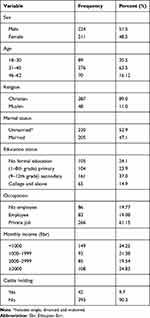 |
Table 1 Socio-Demographic Characteristics of the Study Participants |
Behavioral, Personal and Environmental Characteristics of the Respondents
The present study showed that 160 (36.8%) and 40 (9.2%) of the respondents had the habit of raw milk and meat consumption, respectively. However, 81.6% of the respondents believed that raw milk consumption is the major source of BTB. Among the respondents who owned cattle, 92.85% of the respondents bring their animal to a veterinary clinic when they get sick (Table 2).
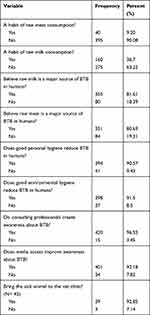 |
Table 2 The Behavioral, Personal, and Environment-Related Responses Among People Living with HIV |
Knowledge Level of Respondents About Bovine Tuberculosis
The result of the present study showed that 57.2% of the respondents knew about BTB. About 243 (97.59%) of the respondents believed that people living with HIV are more prone to bovine TB. Moreover, about 237 (95.18%) of the respondents explained that cough is a major symptom of BTB in humans (Table 3).
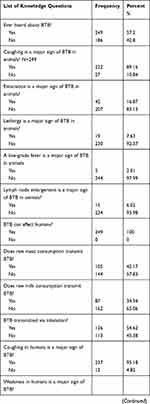 | 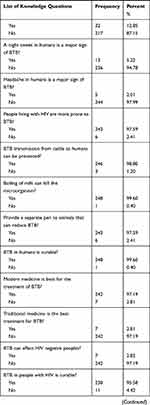 |  |
Table 3 Knowledge-Related Responses Among Peoples Living with HIV in Bahir Dar City Public Hospitals |
The Practice of Respondents About Bovine Tuberculosis
Of the total 435 study participants, only 180 (41.4%) of the participants had a good practice level with 95% CI (0.36, 0.46). About 30.7% of the respondent boil milk before consumption. Among the respondents who owned cattle, about 11.9% of the respondents allowed their cattle to share their home. About 47.6% of the respondents use hand protective materials/gloves while cleaning cattle barns. About 23.8% respondents bring BTB suspected animals to vet clinics. About (69.4%) of respondents believed that BCG vaccine can prevent TB, while 4.3% of them practice traditional medicine (Table 4).
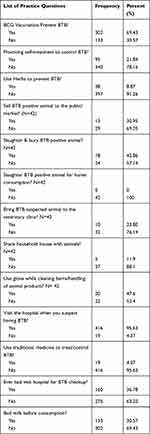 |
Table 4 Participant’s Response to Practice Questions Among Peoples Living with HIV in Bahir Dar Public Hospitals |
Factors Affecting Knowledge for BTB
Education status, religion, cattle holding and environmental hygiene were found to be statistically significant association with knowledge level. The odds of having good knowledge level were higher in respondents with secondary (AOR = 3.60; CI: 1.75, 7.38) and above college (AOR = 2.91; CI: 1.55, 5.43) education than those who did not receive formal education. The odds of having good knowledge are 2.3 times higher in those who owned cattle (AOR = 2.30; CI: 1.06, 4.96) as compared to those who did not own. Besides, the odds of having good knowledge level were 37% smaller among Christian respondents (AOR = 0.37; CI: 0.18, 0 0.75) as compared to Muslims. In addition, the odds of having good knowledge were 3.38-fold higher in respondents with good environmental hygiene (AOR = 3.38; CI: 1.39, 8.23) than those who keep poor environmental hygiene (Table 5).
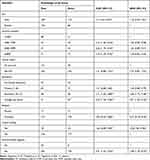 |
Table 5 Multivariable Logistic Regression of Factors Affecting the Knowledge of People Living with HIV About BTB |
Factors Affecting Prevention Practice for BTB
Education, age and marital status were the factors associated with good level of preventive practice for BTB. The odds of having good practice were 2.5 and 4.3 times higher in respondents with secondary (AOR = 2.55; CI: 1.14, 5.69) and college and above (AOR = 4.33; CI: 2.14, 8.77) education than those who did not receive formal education, respectively. Those respondents who aged between 31 and 45 years (AOR = 0.27; CI: 0.15, 0.85) and 46 to 60 years (AOR = 0.38; CI 0.17, 0.85) had 27% and 38% lower level of practice for BTB, when compared to their younger counter parts (18–30). The odds of having good practice were 1.8 times higher in married respondents (AOR = 1.74; CI: 1.06, 2.84) than those unmarried counter parts (Table 6).
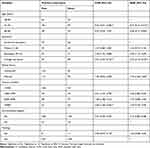 |
Table 6 Multivariable Logistic Regression of Determinant Factors Affecting Practice of BTB Among People Living with HIV |
Discussion
The present study revealed that among the respondents about 57.2% of them were knowledgeable about bovine TB and its derivatives. From those 46.2% of the respondents living with HIV had good knowledge level for BTB in the study area. Among knowledgeable respondents 57.2% of them believed that bovine tuberculosis can be transmitted to humans. Ninety nine percent of them also knew that boiling of milk before consumption can prevent the transmission of bovine tuberculosis to human. A study conducted in Woldiya showed that 48% of respondents knew bovine TB can be transmitted to human and 98% of knowledgeable respondents believe pasteurization of milk can prevent bovine tuberculosis transmission to human.18 Study conducted in and around Mekelle 30.8% of the respondents have good knowledge about BTB and only 15% of the respondents knew that BTB is a zoonotic disease.21 The main reason for the difference in the level of knowledge about bovine tuberculosis could be nearest approach to animal health assistances and veterinarians, so that they could consult animal health professionals for the health care of their animals and zoonoses.18
Among knowledgeable respondents, about more than one-third of respondents believed that BTB can be transmitted to human through eating of raw milk (34.9%) and meat (42.1%). A comparable result was reported from Nigeria by,22 less than half of the respondents knew about BTB as it can be transmitted to human through eating undercooked or partially cooked meat (43.2%) and milk (41.8%). Moreover, 95.1% of the respondents knew that cough is a major symptom of BTB. This finding was similar with the study conducted in Uganda by19 and in Nigeria by.20 However, the present poor level of knowledge (53.8%) was higher when compared with the reports of20,23 and24 in Ethiopia, in Nigeria and in Cameron, respectively. The variation in the different study might be due to close relation between veterinarians and animal owners and also the involvement of people in animal production, health and husbandry that can affect the level of knowledge.23,25
Moreover, the present study showed that, 41.4% of HIV positive people had good level of practice for the prevention of bovine tuberculosis. However, the current finding was found lower when compared with the report in Ethiopia by,18 in Uganda by19 and in Nigeria by,26 who reported 50.8%, 75.2% and 47.9% of the participants had good level of practice, respectively. The low level of practice reported by the current study could be due to the low level of good knowledge of the respondents. Knowledge of a disease promotes the development of appropriate practices.27
Furthermore, the present study revealed that 36.8% and 9.2% of the respondents consume raw milk and meat, respectively. The current finding was lower when compared with the reports of Alelign et al,8 who reported that 69% of the respondents consume raw milk and dairy products in south Gondar zone. Similarly, a study conducted in Yabello showed that 66.2% and 96.5% of the respondents consume raw milk and meat, respectively.28 Moreover, the findings of29 in Arsi zone, Ethiopia and30 in Ghana showed that 55.4% and 40.6% of the study participants consume raw milk, respectively. The inconsistency between the different study might be associated with food consumption behavior and geographical location. Unlike the present study, most previous studies were conducted in rural and agro-pastoral areas, where raw milk and meat consumption are widely practiced. Moreover, it has been reported that lack of knowledge about zoonosis, practices of raw food consumption and poor animal husbandry becomes the factors for increasing the risk of zoonosis in the study participants.22
The predictors of knowledge and practice in this study were education, religion, cattle holding, environmental hygiene, age and marital status. The findings in the present study predicted that those respondents who attend college and above had high knowledge and practice on BTB as compared to those who attend primary and no formal education. Similar findings were reported in Ethiopia by25 and31, and in Nigeria by.22 Providing education plays an important role in adding up knowledge and also played an important role in increasing BTB awareness among the owners of livestock.25
In the present study, respondents aged between 46 and 60 years had lower practice level as compared to Younger’s (18–30). This finding is different from the previous report in Nigeria by20 and22 who reported that respondents in the age group ≥58 years had high knowledge. The knowledge of the respondents increases with increasing years of working experience which is supported by similar study among herdsmen in Ghana, suggesting that it is possible that herdsmen with a long practical experience had a greater knowledge because of past experiences on TB in their herd.20,30 The probable reason why elders had low practice level in the present study might be due to limited access to education and practical training associated with ZTB as compared to Younger’s.
Conclusion
The present study showed that the overall good knowledge and practice level of the HIV positive peoples for bovine TB was found low as compared to other previous similar studies. Raw milk and meat consumptions were still practiced in the study area, which play a crucial role in developing and contracting BTB among immune-compromised individuals due to HIV. Education status, cattle holding, environmental hygiene, and religion, were significant determinant factors of knowledge. Likewise, age, education status and marital status were also predictors of preventive practice of HIV positive people for BTB. Therefore, both human and animal health professionals should apply ONE health approach in which a concerted effort among all relevant stakeholders, is highly needed so as to create/raise awareness, improve knowledge and enhance preventive practice of HIV positive people about zoonotic TB in the study area. Also, further study should be conducted to address the practice level with marital status which is found difficult to address in the present study.
Abbreviations
AIDS, Acquired Immunodeficiency Syndrome; BCG, Bacille Calmette-Guerin; BTB, Bovine Tuberculosis; EPTB, Extrapulmonary Tuberculosis; HIV, Human Immunodeficiency Virus; PTB, Pulmonary Tuberculosis; TB, Tuberculosis.
Data Sharing Statement
The datasets used and/or analyzed during the current study are available from the corresponding author on reasonable request.
Ethical Approval and Consent to Participate
Ethical clearance and approval of the verbal consent was obtained from the Institute of Public Health Research Ethical Review Committee, College of Medicine and Health Science, University of Gondar with reference number 837/6/2012, before the data collection. Then after, informed consent was obtained from each study participant after the purpose and significance of the study is explained to them by the data collectors. The study was conducted in accordance with the Declaration of Helsinki.
Author Contributions
All authors made a significant contribution to the work reported, whether that is in the conception, study design, execution, acquisition of data, analysis and interpretation, or in all these areas; took part in drafting, revising or critically reviewing the article; gave final approval of the version to be published; have agreed on the journal to which the article has been submitted; and agree to be accountable for all aspects of the work.
Disclosure
The authors declare that they have no competing interests in this work.
References
1. Rahman MM, Samad MA. Prevalence of bovine tuberculosis and its effects on milk production in Red Chittagong cattle. Bangla J Vet Med. 2008;6(2):175–178. doi:10.3329/bjvm.v6i2.2332
2. Samad MA. Public health threat caused by zoonotic diseases in Bangladesh. Bangla J Vet Med. 2011;9(2):95–120. doi:10.3329/bjvm.v9i2.13451
3. Watters DAK. Surgery for tuberculosis before and after human immunodeficiency virus infection: a tropical perspective. Br J Surg. 1997;84(1):8–14.
4. Cosivi O, Grange JM, Daborn CJ, et al. Zoonotic tuberculosis due to Mycobacterium bovis in developing countries. Emerg Infect Dis. 1998;4(1):59. doi:10.3201/eid0401.980108
5. Ashford D, Whitney E, Raghunathan P, Cosivi O. Epidemiology of selected mycobacteria that infect humans and other animals. Revue Scientifique Et Technique. 2001;20(1):325–337. doi:10.20506/rst.20.1.1266
6. Ayele WY, Neill SD, Zinsstag J, Weiss MG, Pavlik I. Bovine tuberculosis: an old disease but a new threat to Africa. Int J Tubercul Lung Dis. 2004;8(8):924–937.
7. Collins CH. The bovine tubercle bacillus. Br J Biomed Sci. 2000;57:234–240.
8. Alelign A, Zewude A, Petros B, Ameni G. Tuberculosis at farmer-cattle interface in the rural villages of South Gondar Zone of northwest Ethiopia. Tuberc Res Treat. 2019;2019:1–8. doi:10.1155/2019/2106981
9. Yates MD, Pozniak A, Grange JM. Isolation of mycobacteria from patients seropositive for the human immunodeficiency virus (HIV) in south east England: 1984–92. Thorax. 1993;48(10):990–995. doi:10.1136/thx.48.10.990
10. Schultsz C, Kuijper EJ, Van Soolingen D, Prins JM. Disseminated infection due to multidrug-resistant Mycobacterium bovis in a patient who was seropositive for human immunodeficiency virus. Clin Infect Dis. 1996;23:841–843. doi:10.1093/clinids/23.4.841
11. Michel AL, Müller B, Van Helden PD. Mycobacterium bovis at the animal–human interface: a problem, or not? Vet Microbiol. 2010;140:371–381. doi:10.1016/j.vetmic.2009.08.029
12. Hlavsa MC, Moonan PK, Cowan LS, et al. Human tuberculosis due to Mycobacterium bovis in the United States, 1995–2005. Clin Infect Dis. 2008;47(2):168–175. doi:10.1086/589240
13. Firdessa R, Tschopp R, Wubete A, et al. High prevalence of bovine tuberculosis in dairy cattle in central Ethiopia: implications for the dairy industry and public health. PLoS One. 2012;7(12):e52851. doi:10.1371/journal.pone.0052851
14. Aylate A, Shah SN, Aleme H, Gizaw TT. Bovine tuberculosis: prevalence and diagnostic efficacy of routine meat inspection procedure in Woldiya municipality abattoir north Wollo zone, Ethiopia. Trop Anim Health Prod. 2013;45(3):855–864. doi:10.1007/s11250-012-0298-7
15. Tschopp R, Berg S, Argaw K, et al. Bovine tuberculosis in Ethiopian wildlife. J Wildl Dis. 2010;46(3):753–762. doi:10.7589/0090-3558-46.3.753
16. Kelly TR, Karesh WB, Johnson CK, et al. One Health proof of concept: bringing a transdisciplinary approach to surveillance for zoonotic viruses at the human-wild animal interface. Prev Vet Med. 2017;137:112–118. doi:10.1016/j.prevetmed.2016.11.023
17. Central Statistics Agency (CSA). Central Statistics Agency of the Federal Democratic Republic of Ethiopia. Agricultural sample survey 2016/2017. Report on Livestock and Livestock Characteristics. Vol. II. Addis Ababa, Ethiopia:Central Statistics Agency (CSA);2017:1–36.
18. Wendmagegn O, Negese D, Guadu T. Bovine tuberculosis and associated factors among adult HIV positive people in Woldya Town, Northeast Ethiopia. World J Med Sci. 2016;13(1):38–48. doi:10.5829/idosi.wjms.2016.13.1.101180
19. Kazoora HB, Majalija S, Kiwanuka N, Kaneene JB. Knowledge, attitudes and practices regarding risk to human infection due to Mycobacterium bovis among cattle farming communities in Western Uganda. Zoonoses Public Health. 2016;63(8):616–623. doi:10.1111/zph.12273
20. Hambolu D, Freeman J, Taddese HB, Cattamanchi A. Predictors of bovine TB risk behaviour amongst meat handlers in Nigeria: a cross-sectional study guided by the health belief model. PLoS One. 2013;8(2):e56091. doi:10.1371/journal.pone.0056091
21. Zeru F, Romha G, Berhe G, Mamo G, Sisay T, Ameni G. Prevalence of bovine tuberculosis and assessment of Cattle owners’ awareness on its public health implication in and around Mekelle, Northern Ethiopia. J Vet Med Animal Health. 2014;6(6):159–167. doi:10.5897/JVMAH2014.0288
22. Ismaila UG, Rahman HA, Saliluddin SM. Knowledge on bovine tuberculosis among abattoir workers in Gusau, Zamfara State, Nigeria. Int J Public Health Clin Sci. 2015;2(3):45–58.
23. Tesfaye D, Fekede D, Tigre W, Regassa A, Fekadu A. Perception of the public on the common zoonotic diseases in Jimma, Southwestern Ethiopia. Int J Med Med Sci. 2013;5(6):279–285. doi:10.5897/IJMMS2013.0931
24. Kelly RF, Hamman SM, Morgan KL, et al. Knowledge of bovine tuberculosis, cattle husbandry and dairy practices amongst pastoralists and small-scale dairy farmers in Cameroon. PLoS One. 2016;11(1):e0146538. doi:10.1371/journal.pone.0146538
25. Asebe G, Gudina E. Community knowledge, attitudes and practices on bovine tuberculosis and associated risk factors in Gambella Regional State Lare Woreda, South West Ethiopia. Veterinaria. 2018;67(1):27–35.
26. Agada CA, Mohammed J, Okoh AEJ, Ogugua AJ. Occurrence of tuberculosis and predictors of zoonotic TB transmission among livestock workers in Lafia, Nigeria. Sokoto J Vet Sci. 2019;17(4):35–50. doi:10.4314/sokjvs.v17i4.5
27. Wang M, Han X, Fang H, et al. Impact of health education on knowledge and behaviors toward infectious diseases among students in Gansu Province, China. Biomed Res Int. 2018;1–12. doi:10.1155/2018/6397340
28. Wario E, Tehetna A, Zewdie W. Assessment of community awareness on common zoonotic disease in and around Yabello District of Oromia Regional State, Ethiopia. Multidisciplin Adv Vet Sci. 2018;2(4):388–394.
29. Tschopp R, Abera B, Sourou SY, et al. Bovine tuberculosis and brucellosis prevalence in cattle from selected milk cooperatives in Arsi zone, Oromia region, Ethiopia. BMC Vet Res. 2013;9:163. doi:10.1186/1746-6148-9-163
30. Addo KK, Mensah GI, Nartey N, et al. Knowledge, Attitudes and Practices (KAP) of herdsmen in Ghana with respect to milk-borne zoonotic diseases and the safe handling of milk. J. Basic Appl. Sci. Res. 2011;1(10):1566–1562
31. Kerorsa GB. Assessment of public awareness on common zoonotic diseases in Lalo Kile District, Kellem Wollega Zone, Ethiopia. Young. 2019;101:22–95. doi:10.11648/j.ijbecs.20190504.11
 © 2021 The Author(s). This work is published and licensed by Dove Medical Press Limited. The full terms of this license are available at https://www.dovepress.com/terms.php and incorporate the Creative Commons Attribution - Non Commercial (unported, v3.0) License.
By accessing the work you hereby accept the Terms. Non-commercial uses of the work are permitted without any further permission from Dove Medical Press Limited, provided the work is properly attributed. For permission for commercial use of this work, please see paragraphs 4.2 and 5 of our Terms.
© 2021 The Author(s). This work is published and licensed by Dove Medical Press Limited. The full terms of this license are available at https://www.dovepress.com/terms.php and incorporate the Creative Commons Attribution - Non Commercial (unported, v3.0) License.
By accessing the work you hereby accept the Terms. Non-commercial uses of the work are permitted without any further permission from Dove Medical Press Limited, provided the work is properly attributed. For permission for commercial use of this work, please see paragraphs 4.2 and 5 of our Terms.

